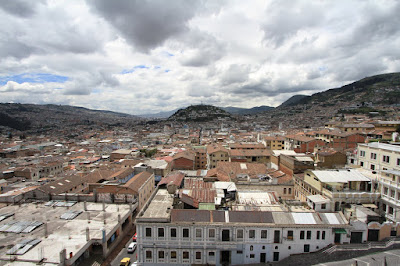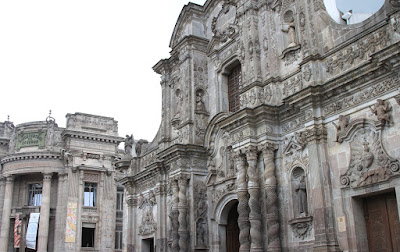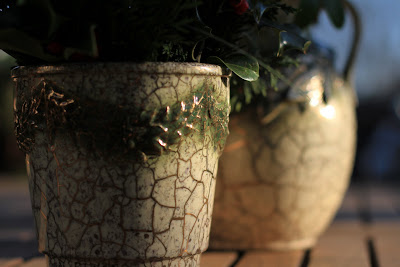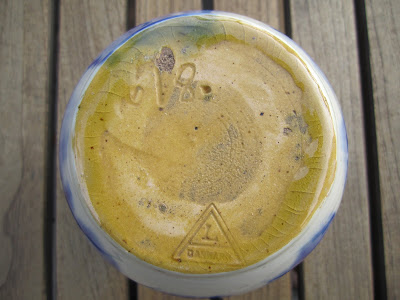

Views from Basilica of the Nacional Vow


We spent ten days in Ecuador, seven of which were spent in the Galápagos Islands. This left just a very small bit of time to explore Quito, the capital of Ecuador. Therefore, we only spent two full days in Quito and small parts of two other days while in transit to and from Quito.
Reading Up Before We Left
Here are a few things we read before landing in Quito.- Split Personality and City of Blood? The article Quito: Blood, Guts and Pizarro’s Bequest from the site Ecuadorial says that Quito has a split-personality. “Quito, like Ecuador itself, suffers from a split personality. To the south the old town, a Florence of the New World, all dreaming spires and towering belfries, gleams white in its valley beneath the high Andean sun. To the north, the new town, with its mirrored tower blocks, swanky hotels, overpasses and roundabouts, congested with grey, anonymous modernity. The contrast couldn't be greater, and at some 2,800 meters, clearer.”
- Safety? We made the “mistake” of reading the U.S. Department of State’s info on Quito. Seriously, you should read it, but, be forewarned, if you are the worrying type you may have the urge to throw your hands up in the air and just stay home. For example, we were worrying about “Secuestro Express” taxi assaults before the ink of the airline tickets was barely dry.
- Health Concerns? For travelers like us, unfamiliar with traveling in South America, there was some time spent puzzling over what health issues we should be concerned about. Would we get yellow fever, dengue fever, malaria or chagas? The descriptions of the diseases make a mugging seem preferable. Anyhow, the U.S. Department of State has some info on Quito health as well as the Centers for Disease Control and Prevention (CDC) that is worth reading.
- Florence of the New World? Quito was one of the first World Cultural Heritage Sites declared by UNESCO in 1978. It’s a capital city. It’s in a stunning location at 9,000 feet and surrounded by mountains. UNESCO states that it is the “least altered historic centre in Latin America” and that the monasteries and churches in the historic center “are pure examples of the ‘Baroque school of Quito’, which is a fusion of Spanish, Italian, Moorish, Flemish and indigenous art.”
Quito Old Town Street Scene and La Ronda


Impressions on the Ground
Here is what we experienced in Quito.- Split Personality and City of Blood? At first glimpse, Quito seems like an undifferentiated mass spreading in all directions. The view from El Panecillo is sobering: a mass of concrete and structures pushing up against the mountains. In fact it’s hard to see where the old and new town borders are. San Francisco de Quito, usually just shortened to Quito, has a metro area size approximately the same as Seattle, 3+ million people, but feels larger.
No, the split personality wasn’t one of the physical layout of Quito, rather, it was more one of our experience on the street, in the old town. One hand we were going through our usual tourist motions - make a beeline to the main cathedral, pop into this site, etc. etc.- yet something seemed decidedly un-touristic. The people on the streets seem disinterested or at most uncertain of their roles as players in our tourist game. I guess this is a thankful situation because it carries a degree of authenticity or untouched-ness? Life seems to carry on whether we visit or not.
In the old town, everything is for sale and it might just be heading your way on the sidewalk! Peripatetic vendors. There are the sellers of lottery tickets and newspapers announcing their items. Indigenous women with babies on their backs selling six avocados, fresh pineapple slices from a tray, or cherries in a basket. Ice cream on the go? Sure, two women are chatting as they carry mounds of something vaguely resembling ice cream in Tupperware containers. The cones stuck in the top of the mounds give a clue. Micro-candy stalls sprout on the sidewalks. And, there are more baby Jesus outfits for sale than you would think one city could support. All this while the traffic moves in fits and spurts and fumes pour out. Then, suddenly school girls in impossibly white socks walk by and lighten up an otherwise gray street, oblivious to it all. This is the split personality we experienced and it was more of our problem than Quito’s. Our guide in the Galapagos, a resident of Quito, said that he and his friends say that Quito is bi-polar and we think he meant it on several levels but are still puzzling through the meaning.
- Safety? Thankfully, we did not run into any problems in regard to safety. We walked for miles around the old town during the first day. There were many police in plain sight. We walked back from a restaurant in the old town around 10pm and didn’t notice anything unusual. On the second day, we hired a taxi by the hour for the day - wisely suggested by our hotel staff and they also picked the taxi for us as one they worked with before. The taxi shuttled us between sites, dropping us off and picking us up at pre-defined times. For the whole day we paid $40 - well worth it. All transportation to and from the airport was arranged by our travel agent (Columbus Travel) ahead of time. It was especially nice to arrive at 12:30am in the morning in Quito and see Javier holding up a sign with our name.
- Health Concerns? In Quito and the Galápagos we didn’t have too much to worry about. All the scariest diseases were either not an issue or very low risks. We were surprised that we ran into almost no mosquitoes to speak of in Quito or the Galápagos. We could have just been lucky. Diseases from water are still always a risk and we did get “bit” by this. Thankfully it hit us toward the end of our 10 days in Ecuador so it didn’t stop us.
- Florence of the New World? We would say that Quito, especially the old town, has a ways to go to work itself into this nickname’s shoes. The structure of the old town has all the elements going for it, interesting structures, plazas for gathering, and a density of interesting sites to visit. However, it doesn’t quite all come together, yet. They seem to be working hard at it. Our hotel for example is an example of buildings being restored and attracting tourists.
The Roof of the Basilica’s Nave

What We Saw
Day 1: Basilica of the National Vow. We walked to this church from our hotel. The basilica is a bit run down and need of some basic repairs. It does have some impressive views from different balconies or perches you can reach by stairs or ladders (literally).Day 1: The Church of the Society of Jesus or La Compañía de Jesús. After the Basilica, we walked back to the center of the old town to this gold-leafed-Baroque extravaganza. Inside an English speaking guide, Alex (studying tourism), gave us a short tour.
Day 1: Church and Convent of St. Francis, Museo Fray Pedro Bedón. First, we ate lunch at the popular Tianguiez at the foot of the convent. Inside the convent, the Museo Fray Pedro Bedón has a display of religious art that demonstrates the more gruesome depictions of Jesus that are favored by the Quito school. All the better to instill fear in and connect to the hearts and minds of the indigenous people to be converted. Again, we refer to the article mentioned above in the Ecuadorial for more background reading.
Day 1: Virgen de Quito on El Panecillo. We walked up to this city icon in the late afternoon. A series of staircases (some not finished) take you up from the old town. When you go by foot though, be warned there are posted notices about NOT walking there. The view from the top gives you another glimpse of the spread of the city and, if the weather cooperates, a glimpse of the mountains and volcanoes cradling the city.
Day 2: TelefériQo. We took a taxi from our hotel to the base of gondola (10,226 ft) and arranged for the taxi to pick us up after a couple of hours. At the top of the gondola (12,943 ft), we met misty weather so just walked around a bit and headed back down. There is little signage or explanation - that we could tell - that explains what you might see or experience up there. There are amenities at the top: café, restaurant, shops - but many were closed when we went up in the early to mid-morning. We would definitely like to go back to the top under nicer weather.
Day 2: Foundación Guayasamín. The Guayasamín museum contains the works and art collection of Oswaldo Guayasamín (1919 - 1999), a Quechua native and Ecuadorian artist. His work often features tortured faces and hands, like the series La Edad de la Ira (The Age or Rage). The museum combined with his La Capilla del Hombre (The Chapel of Man), located 5 blocks away, can take a few hours to visit and is well worth the time. Take a taxi to get to the museum - it’s not something you can easily walk to it. For more about our time in the Guayasamín museum see this post.
Day 2: Casa del Alabado. This is a new museum in the old town focusing on pre-Columbian art. It’s a beautifully done museum. You will see a lot of beautiful artifacts with a brief description of what the object is and the period designated by a particular culture such as Valdivia (4,000 a.C. - 1,500 a.C) or Chorrera (950 a.C. - 350 a.C.). On the second floor there is a room that helps visitors decipher these designations. It is probably best to visit this room first. There is documentary film about the construction of the museum that features the stories of the people who helped restore the building that houses the museum.
La Casona de la Ronda

Where We Stayed and Ate
We stayed at La Casona de la Ronda - a recently refurbished structure - and beautifully done at that. We stayed at the hotel two nights before visiting the Galápagos and two nights afterward. We would highly recommend this hotel. Most tourists seem to stay in the Mariscal neighborhood, but from what we saw, we’d pick the old town any day. From La Casona de la Ronda we could walk within five minutes to all the key sites.We ate one night at our hotel and it was very good. Two other nights we ate at Theatrum Restaurante & Wine Bar (old city center) and La Gloria Restaurant (edge of Mariscal) - both upscale restaurants with good food. The dessert at Theatrum was especially interesting. It was assortment of different preparations of fruits of Ecuador. See this post for details of the dessert.
We ate one lunch at the popular Tianguiez, at the foot of the San Francisco complex and overlooking the Plaza de San Francisco. It is popular with tourists and safe if you don’t want to negotiate the intimidating food vendors and shops that are all over the old town.
Tickets from Quito Tourist Sites



Two Restaurants in Quito



Basilica of the Nacional Vow – Climbing to the Top



Agave and Staircase

Plaza de San Francisco

Inside Convent of San Francisco

Iglesia de la Compania de Jesus

Caution Sign – Walking Up to El Panecillo

View of El Panecillo from La Ronda

La Virgen del Panecillo



















